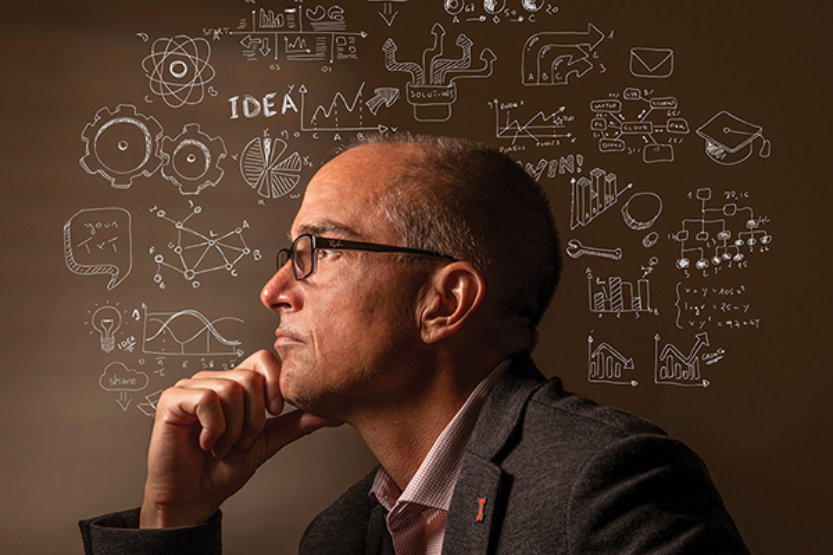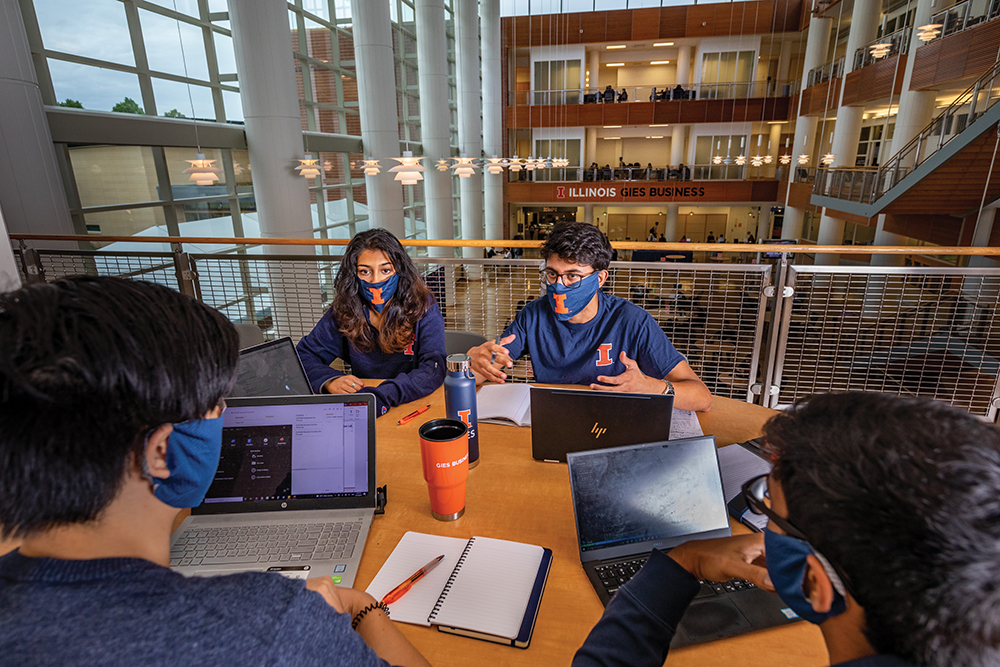Disruptor-in-Chief
 Robert Brunner embraces the idea of breaking new boundaries as the Chief Disruption Officer at the Gies College of Business. The Disruption Lab is designed to bring to life ideas using new technology in brand new ways as collaborators from inside and outside the university work to develop projects with practical application for Gies College of Business, the larger University, and partners in the business world. (Image by Fred Zwicky)
Robert Brunner embraces the idea of breaking new boundaries as the Chief Disruption Officer at the Gies College of Business. The Disruption Lab is designed to bring to life ideas using new technology in brand new ways as collaborators from inside and outside the university work to develop projects with practical application for Gies College of Business, the larger University, and partners in the business world. (Image by Fred Zwicky) When Robert Brunner, Ph.D., says new technologies aren’t rocket science, he speaks from experience—he holds a doctoral degree in astrophysics and was professor of astronomy before coming to the Gies College of Business in 2017.
Now, he’s the College’s associate dean for innovation and chief disruption officer, a position created for him in 2019. One of his charges, as he sees it, is to demystify emerging tools such as blockchain and artificial intelligence for students and faculty alike. That way, the school can forge ahead into a brave new future.
In fall 2020, Brunner oversaw the launch of the Disruption Lab—not a physical space, but an avenue for collaboration through which participants explore and iterate on groundbreaking concepts. Here, he talks about the lab’s origins, operations and impact.
Let’s start with a basic question: How do you define disruption?
There’s this tendency to think of disruption as a negative thing. The student in the class was disruptive, and the whole class went off the rails; something disrupted my train of thought. But disruption is simply change. The positive or negative is the way you deal with it—whether you pay attention, anticipate and adjust. Why was the child disruptive in the classroom? It might have been that he or she was bored, and the teacher was too busy with other students. If we think ahead and prepare, we can plan to support and nurture those students.
How does it impact the business world?
Corporations are affected by many types of disruption—political instabilities, natural disasters, changes in society and culture. You can’t control those, but you can try to prepare and respond. Then there are emerging technologies, such as blockchain, cryptocurrency, augmented reality, virtual reality, metaverse, artificial intelligence and autonomy. Here, you can start to think about what new opportunities are presented by these technologies and how to capitalize, either to gain market share or create a startup to fill the void.

Student project teams drawn from different academic majors and parts of campus work together for a semester to build a prototype or proof-of-concept. (Image by Fred Zwicky)
Why and how did the Disruption Lab come to be?
At any university, it’s difficult to create new curriculum. If I wanted to introduce a series of courses, or to modify existing courses to add content that covers these topics, it would take years, perhaps a decade. Obviously, that defeats the purpose—this is stuff happening now. So in the meantime, I wanted to give students an experiential learning opportunity to, not just read about technology, but to build things with it.
Around the time I was named chief disruption officer, I wrote a white paper outlining the idea for the lab and received some funding from Gies. We were planning to officially launch with a big event in April 2020—but then in March, we were disrupted by the pandemic. So we did a soft launch in the fall, and now can finally talk to people about what we’re doing.
What are the different components of the Disruption Lab?
One of the core features is what I call the student projects. Some are created by me or others in the college or on campus, and some come from outside companies. We have a student-led organizational structure, mentored by [Director] Jacob Kinsey, ’06 LAS, MBA ’16, which recruits diverse teams of students from across campus, in different majors, to work together for a semester. The point isn’t to build a polished product to distribute, it’s to build a prototype, proof-of-concept of whether something is feasible.
One of the things I realized early on is that a company—or us, as a university—may say: We actually want a finished product. You showed us it’s going to work; let’s push it across. So we created Skunkworks, named after a facility at Lockheed Martin. We build teams with members that will be able to stick together longer-term and explore how to go from a prototype all the way to implementation.
What types of projects has the Disruption Lab been working on?
We’re building a blockchain for the college, then starting to build applications on top of it. One of the first is a supply chain management application for our marketing communications group. We have other ideas.
Right now, we give students extra credit for attending events, like accounting department lyceums. When they walk in, they get a Scantron to fill out and return. That seems old-school, right? With blockchain, we could scan their faces when they come in, or have them swipe a card or show their phone, then develop a separate application that keeps track of these points. We could even give them something in return—maybe a Giescoin, which could be turned into swag. There are lots of opportunities based on one simple idea. This progress can’t come from one person sitting in an office—we bring in undergrads and grad students from across campus.
What do you hope students will gain?
Depending on how they plug in, students can get the entire perspective, from being curious about innovations and disruptions around technology to making a prototype to working longer in Skunkworks. They can say, this is what I want my career to be. Maybe they want to do a startup in this space. I always emphasize to people that a startup isn’t the only option. You can be intrapreneurial, entrepreneurial inside a company, and help them be innovative and nimble.
What about the school as a whole?
As a university, we’re already leaders in the data analytics space. This push into disruptive technologies may be even bigger. We have the opportunity to be the most innovative business school, and because we’re in this position now, others will struggle to catch up.
Defining Disruption with Chief Disruption Officer Robert Brunner

